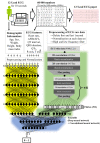Deep Learning-Based Algorithm for Detecting Aortic Stenosis Using Electrocardiography
- PMID: 32200712
- PMCID: PMC7428650
- DOI: 10.1161/JAHA.119.014717
Deep Learning-Based Algorithm for Detecting Aortic Stenosis Using Electrocardiography
Abstract
Background Severe, symptomatic aortic stenosis (AS) is associated with poor prognoses. However, early detection of AS is difficult because of the long asymptomatic period experienced by many patients, during which screening tools are ineffective. The aim of this study was to develop and validate a deep learning-based algorithm, combining a multilayer perceptron and convolutional neural network, for detecting significant AS using ECGs. Methods and Results This retrospective cohort study included adult patients who had undergone both ECG and echocardiography. A deep learning-based algorithm was developed using 39 371 ECGs. Internal validation of the algorithm was performed with 6453 ECGs from one hospital, and external validation was performed with 10 865 ECGs from another hospital. The end point was significant AS (beyond moderate). We used demographic information, features, and 500-Hz, 12-lead ECG raw data as predictive variables. In addition, we identified which region had the most significant effect on the decision-making of the algorithm using a sensitivity map. During internal and external validation, the areas under the receiver operating characteristic curve of the deep learning-based algorithm using 12-lead ECG for detecting significant AS were 0.884 (95% CI, 0.880-0.887) and 0.861 (95% CI, 0.858-0.863), respectively; those using a single-lead ECG signal were 0.845 (95% CI, 0.841-0.848) and 0.821 (95% CI, 0.816-0.825), respectively. The sensitivity map showed the algorithm focused on the T wave of the precordial lead to determine the presence of significant AS. Conclusions The deep learning-based algorithm demonstrated high accuracy for significant AS detection using both 12-lead and single-lead ECGs.
Keywords: aortic valve stenosis; deep learning; electrocardiography.
Figures




Comment in
-
Going Deep With ECG and Aortic Stenosis: Touchdown or Incomplete Pass?J Am Heart Assoc. 2020 Apr 7;9(7):e016193. doi: 10.1161/JAHA.120.016193. Epub 2020 Mar 21. J Am Heart Assoc. 2020. PMID: 32200715 Free PMC article. No abstract available.
References
-
- Kodali SK, Velagapudi P, Hahn RT, Abbott D, Leon MB. Valvular heart disease in patients ≥80 years of age. J Am Coll Cardiol. 2018;71:2058–2072. - PubMed
-
- Carabello BA, Paulus WJ. Aortic stenosis. Lancet. 2009;373:956–966. - PubMed
-
- Bonow RO. Exercise hemodynamics and risk assessment in asymptomatic aortic stenosis. Circulation. 2012;126:803–805. - PubMed
-
- Leon MB, Smith CR, Mack M, Miller DC, Moses JW, Svensson LG, Tuzcu EM, Webb JG, Fontana GP, Makkar RR, et al. Transcatheter aortic‐valve implantation for aortic stenosis in patients who cannot undergo surgery. N Engl J Med. 2010;363:1597–1607. - PubMed
Publication types
MeSH terms
LinkOut - more resources
Full Text Sources
Other Literature Sources
Medical
Research Materials

